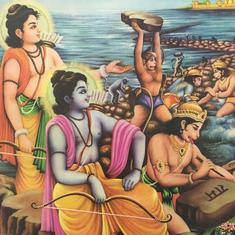The whispers had started as soon as the Bharatiya Janata Party lost the election to the Lalu Prasad-Nitish Kumar combine in 2015. Will "jungle raj" be back, asked people. After all, it was under Prasad in the 1990s when, as it widely believed, Bihar saw its first spell of "jungle raj”. Lawlessness.
Those voices have now become bolder, turning from a murmur to an angry assertion, as an 18-year old was shot dead allegedly by the son of a Janata Dal (United) legislator on Saturday. The motive for the murder? Aditya Sachdeva overtook the car of Rakesh Ranjan Yadav, which resulted in a row. Yadav, in a fit of rage, allegedly shot Sachdev dead. While Yadav’s mother in a JD(U) legislator, his father, Bindi Yadav is a bahubali, strongman. In 2011 Bindi Yadav was arrested after the police recovered a large cache of explosives, rifles and ammunition from his vehicle.
A display of brutal political power, a Yadav strongman and the Rashtriya Janata Dal in power: bingo! jungle raj. Or at least Times Now, India’s most popular English-language news thought so, backed up by a large segment of upper-class Indian opinion.
If police of the state is forced to act because of media pressure, is it not jungle raj? Tweet your take.Join the campaign #JusticeForAditya
— TIMES NOW (@TimesNow) May 11, 2016
Objective measure
Fumbling for a reply, Bihar’s deputy chief minister Tejaswi Yadav came back with what seems at first a slightly odd analogy: if an incident of road rage is jungle raj then what about Pathankot? Isn’t one of the country’s most secure army bases getting attacked with ease by Pakistani militants also a sign of jungle raj? After all, Tejaswi Yadav claimed, the Bihar government was doing all it could to prosecute the crime: Rakesh and his father have been arrested and his mother suspended from the party.
Yadav might need to work on his debate skills a bit but the point he’s making can’t be dismissed altogether. How do we objectively claim that Bihar is now under “jungle raj”?
Jungle raj or the rule of the jungle refers to a state of lawlessness. In this case, Tejaswi Yadav’s case is a valid one. If the Bihar government really does prosecute this murder, then it’s a case of the law actually functioning rather well rather than an example of jungle raj.
Haryana and Gujarat
However, if we really want an example of lawlessness, a complete and total breakdown of law and order, we don’t have to look far. In February, Haryana was in that exact state for about a fortnight as roving bands of Jats went about burning, looting and allegedly even raping, demanding backward class reservation for themselves. So immense was the scale of disorder that Jats, in a move that almost resembles an act of war, threatened to cut off the capital’s water supply. The armed forces had to be called it to protect Delhi from the Jats – recalling anxieties last evoked in 1857.
For reason best know to it, the Bharatiya Janata Party government treated the rioters with kid gloves, letting them conduct their violence with impunity. In fact, the rioters were even rewarded for the bedlam: in April, the Haryana government agreed to the rioters demands and approved backward class reservation for the Jats, Haryana’s most prosperous and powerful caste. Yet, no one called this “jungle raj”. It wasn't just the government – even the media was complicit. Many media outlets called the widespread destruction caused by roving bands the “Jat quota stir”. Not a “riot” but a “stir” – as it were referring to a new pop album or Twitter trend.
In another BJP-ruled state Gujarat, mass violence has also been witnessed. After the 2002 anti-Muslim pogrom, 2015 saw widespread caste riots that paralysed the state with Patels, like the Jats, asking for reservations in spite of the being the state’s dominant political community. But again, no one's screaming “jungle raj”.
Bias not fact
Clearly then, there is no detached way to decide what is or is not jungle raj. Even during Lalu Yadav’s rule in the '90s, while lawlessness was rampant, was it really higher than in an earlier period? Under Congress rule, upper-caste domination of the state was so complete as for it to be practically lawless – if you were a backward caste. Of course, the difference during Lalu Raj was that upper castes were, in whatever limited way, getting attacked – mostly by the now-dominant Yadavs. Was this violence more intense than, say, during Bihar’s millenia long tradition of anti-Dalit violence? Again, objectively no. Yet, it’s the 1990s that are termed jungle raj and not the 1960s. It's a somewhat similar situation today.
Bihar is India's most enduring stereotype of a backward, rural area. There are comic videos poking fun at the fact that “Bihari” is a near-stand for “yokel” in large cities like Mumbai. In another social media joke reflecting urban India's prejudices, someone simply translated the names of popular Hollywood movies into Bhojpuri as a joke. So poor is Bihar's reputation in the eyes of urban India that just a language from the state, spoken by millions, is in itself funny – you don't even need to add any explicit humour to that.
Combine this Bihar sterotype with the the fact that in 2015 Bihar Assembly elections, the upper castes turned out as a solid votebank for the Bharatiya Janata Party – and against the Janata Dal (United)-Rashtriya Janata Dal coalition. Like the 1990s, it seems allegations of "jungle raj" are largely a function of upper castes – who control the media narrative – being out of power and feeling threatened rather than any obective analysis of lawlessness in Bihari society.










